A nest box newbie in the schoolyard
By Anthony DeCicco
Success! Pure thrilling success. I screamed “Yes!” this spring when I first saw a pair of adult Western Bluebirds entering the nest boxes made by third-grade students at Lake Elementary School in the North Richmond area.
Over the past couple of years, we’ve added a Bird-Friendly Schools component to our award-winning Eco-Education program. As part of that, the Lake Elementary students and I had determined that their grassy field would be an ideal Western Bluebird habitat. (We had help from Golden Gate Bird Alliance bluebird maven Rusty Scalf.)
The Lake third graders built the nest boxes last year, and this spring we attached them to the chain-link fence along the kids’ playing field. At nearby Montalvin Elementary, we did the same with our fourth-grade Eco-Ed classes.
I was a “nest box newbie” and had never thought about the challenges involved in producing a brood of chicks. The day after that thrilling moment of first seeing the pair, reality struck. “Okay, they like the nest box… now what?”

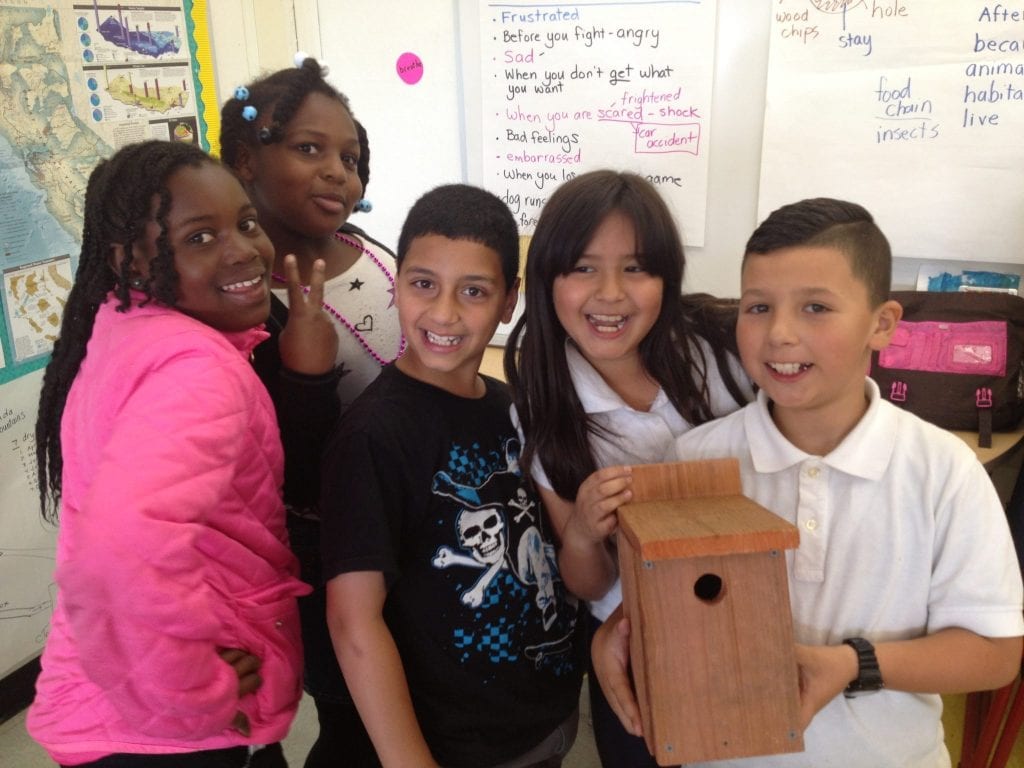
I obsessively consulted various books and websites. It seemed that the more I knew, the more anxiety-ridden I became. I desperately wanted that pair to raise successful chicks so that the kids could marvel over the new life they helped foster. But my goodness, how many factors could ruin that wonderful vision: raccoons, opossums, snakes, cats, starlings, House Sparrows, House Wrens, wasps, ants, black flies, rats – aughhh!!
I had done enough research to know that the 10-foot-long metal pole to which we attached the boxes would eliminate most of the predators. But no resource could advise on how to deal with pesky second-grade boys (not in our Eco-Education program!) opening the boxes, shaking the poles, or throwing rocks in the entry hole. I opted to screw all sides of the nest boxes shut, which forced me to monitor the progress of the nesting pair though observation from a distance with optics rather than quickly lifting a side. But whatever it took was fine. I wanted chicks to hatch and fledge!
The North American Bluebird Society suggests monitoring an active nest box at least once a week. If you don’t see either parent, they recommend observing the site for at least 30 minutes, sometimes one hour. And so I did for the next several weeks amidst groups of curious kids on their recess, who came up to ask what I was doing with the binoculars and scope.
Some of these curious onlookers were from the classes that had built the boxes during the previous school year. “Remember those boxes we made,” I told them proudly. “There is a male and female Western Bluebird making their nest inside….we might have chicks soon”! I was much more excited than the kids were.

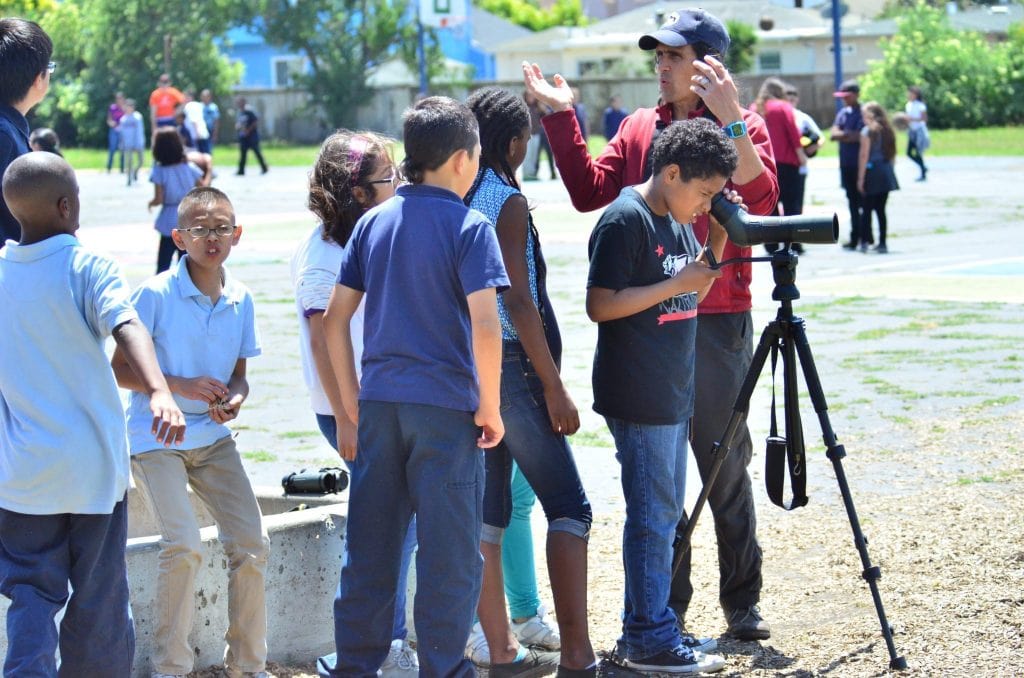
About two weeks later at Montalvin Elementary, we had another triumph: another nesting pair of Western Bluebirds. “Man, this is SO exciting,” I thought to myself, “I could just do this all year-long!”
I brainstormed ways for the kids to better connect with all the excitement and decided it would be fun for them to monitor the boxes themselves. So I loaned the each school a scope donated by Golden Gate Bird Alliance members. (Thanks, keep them coming!) The teachers said that they would have the kids keep a journal. Sometimes we all lined up at a safe distance from the boxes and marveled together over the beautiful flashes of blue as both parents came and went, foraging for insects.
As the weeks progressed, we waited desperately for the sight of chicks poking their heads out of the box. With each day of observation, the anticipation built. Some days, however, I was thoroughly confused. “The female is not staying in the box now, she’s exiting but she’s not foraging….what does that mean? Oh god, what if she has given up….that means they’ve died already — oh no!” Some days I thought anxiously “What is happening in there?!! I wish I could open that box and peek inside!” That was not an option, however, since it could have forced the chicks to fledge prematurely.
There was only one solution to the madness — call Rusty, who suggested that I simply walk up to the box, stand underneath, and listen for chirping. I did just that and was thrilled to hear a cacophony of squeaks! I was the proud human father for a clutch of baby bluebirds. I wanted to tell everyone who’d listen.
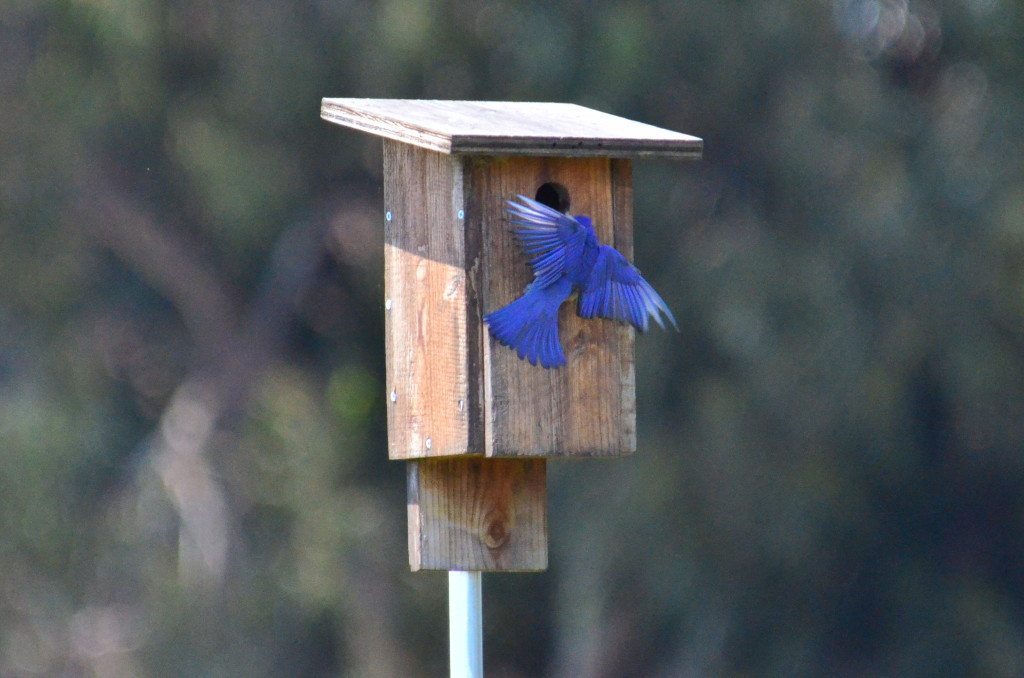
A few days later a heat wave struck. My paranoia returned. “Oh no, the box is fully exposed to the sun, those chicks are going to roast! Did we make the air holes big enough?”
With some more research, I learned that shade structures are used in hot climates. I grabbed some scrap plywood and enlisted the help of Henry Rosenfeld, our intern from Albany High School. We got both sites done without freaking out the parents. Whew, one less thing to worry about!
Now I could only monitor and hope for the best. I watched both mother and father working so hard to catch insects. It seemed that their success rate was about 25 percent for each dive to the ground. I recalled the bluebird websites suggesting the placement of mealworms near the nest box, so off to the pet store I went. But placing mealworms in a schoolyard proved tough, with the only option a pie tin on top of soccer goal posts. I sat and waited for the birds to snatch them up. No action. “This is hopeless,” I thought, “I can’t keep coming out here to give them mealworms.”
Time to consult Rusty again, who warned me that mealworms should be dusted with calcium citrate powder to prevent the chicks from developing a calcium deficiency in their bones. Enough said. I was done; I would just calmly wait and let nature take its course.
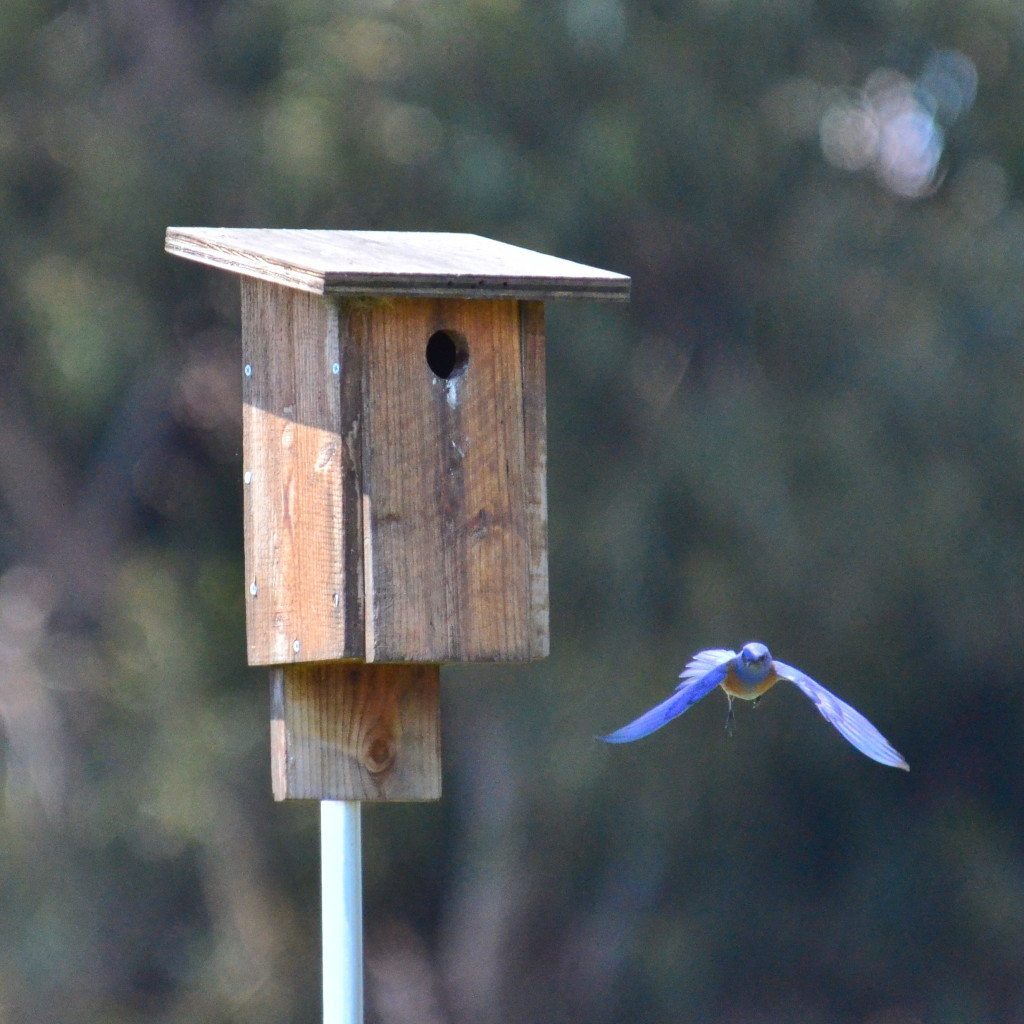
With heightened patience, I continued monitoring. Ten days later at Lake Elementary, I saw that the parents had stopped entering the box. I saw what I thought was a group of females on top of the orange pylons near the playground, but no fledglings. I was thoroughly confused again!
Then, a day or two later, in the park near my house, I coincidentally noticed a Western Bluebird family with fledglings urging their parents for food. I focused on their markings: flecks of brown feathers on the chest, white ring around eye, some blue on the wings and tail. “Wait a second,” I laughed to myself, “those look like the ones from Lake Elementary, the ones I thought were females!”
I was so excited to return to school the next day. My hunch was confirmed—three fledglings! I rushed to share the news with our Eco-Education classes. I was so excited I told the secretary and principal on the way out, “Your students successfully raised a family of Western Bluebirds!”
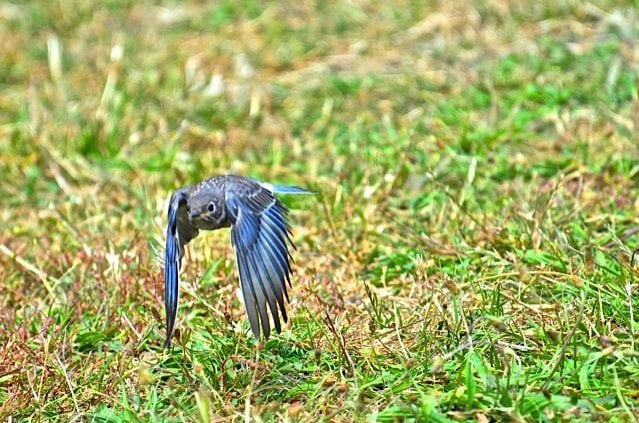
Three weeks after they were first spotted, all three precious fledglings were perched on a single tree on the playing field where they were born. We wish them good fortune in making their own clutches someday.
This year, we had our Eco-Education students build nest boxes for the smaller cavity-nesting birds commonly found around their schoolyard – like Chestnut-backed Chickadees and Oak Titmice – as well as for Barn Owls. And this time around, we designed the boxes so that I will be able to open a side door and peer inside using a VERY tall ladder! Let’s hope for the same success we experienced with the Western Bluebirds.
We plan to expand our Bird-Friendly Schools initiative to new schools in 2015-16. If you’d like to support us by donating your time, skills, or resources, please contact Youth Education Director Anthony DeCicco at adecicco@goldengatebirdalliance.org.
—————————————
Resources for building and monitoring a Western Bluebird nest box
Web sites:
Sialis bluebird site
North American Bluebird Society
Cornell’s NestWatch program
Books:
Audubon Birdhouse Book, by Margaret A. Barker and Elissa Wolfson
Birds in Nest Boxes: How to Help, Study, and Enjoy Birds When Snags are Scarce, by Charlotte C. Corkran
Bird Homes and Habitats, by Bill Thompson III
